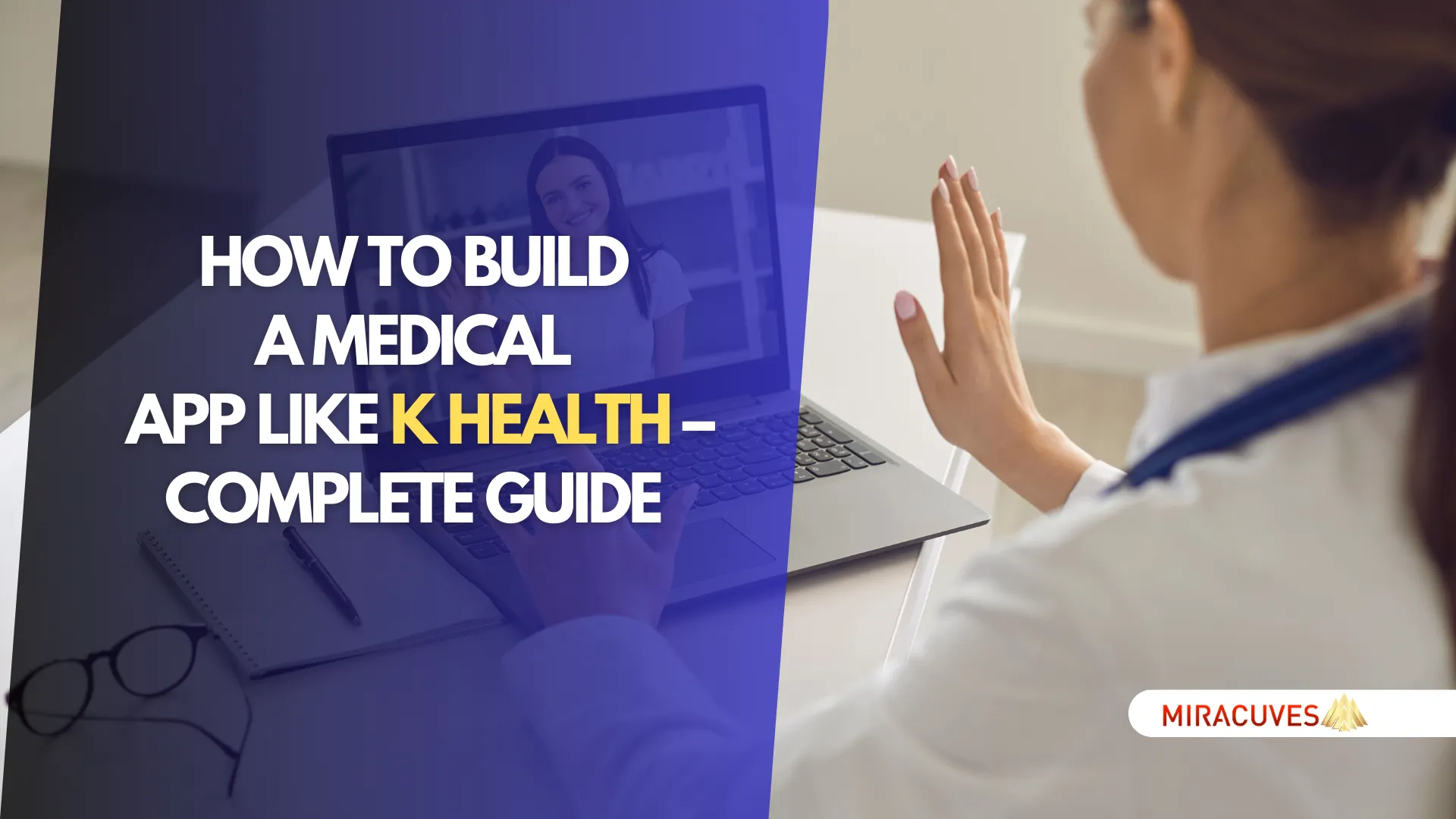In a world where healthcare is rapidly shifting towards digital platforms, apps like K Health are transforming the way people access medical services. By combining AI technology with real-time consultations, K Health has made healthcare more accessible, affordable, and convenient for millions. Whether it’s checking symptoms, consulting with doctors online, or managing medical records, K Health offers an all-in-one solution that resonates with the modern consumer’s need for fast, reliable healthcare.
As more people turn to telemedicine and digital health platforms, the demand for similar apps is on the rise. If you’ve been thinking about creating a healthcare app like K Health, this guide is your starting point. We’ll dive into every detail of the process—from understanding the core features to exploring cost-saving strategies. By using ready-made solutions, you can reduce development time, minimize costs, and still offer a top-tier healthcare experience.
In today’s competitive landscape, building a telemedicine app isn’t just a technical endeavor—it’s a strategic move to tap into a growing industry that’s reshaping healthcare worldwide.
What is K Health and What Does It Do?
K Health is a groundbreaking telemedicine app that uses artificial intelligence (AI) to provide users with accurate, affordable healthcare services directly from their smartphones. Its main draw is the AI-powered symptom checker, which allows users to input symptoms and receive medically-sound suggestions based on millions of clinical data points. The app then provides a possible diagnosis, gives health advice, and offers options to consult with a real doctor—all without needing to leave home.
In addition to its symptom checker, K Health connects users to licensed doctors through a telemedicine platform. These doctors can offer consultations, diagnose illnesses, and even prescribe medication when necessary. The app provides everything from routine checkups to personalized treatment plans, making it a comprehensive healthcare solution.
K Health stands out in the telemedicine industry because of its focus on affordability. Users can access these services for a fraction of the cost of traditional in-person visits, which is especially beneficial for those without insurance or with limited access to healthcare providers. The app also stores health data securely, allowing users to keep track of their medical history in one convenient place.
Key Features of K Health:
- Comprobador de síntomas basado en IA: Uses machine learning to analyze symptoms and suggest possible conditions.
- Telemedicine Consultations: Connects users with licensed physicians for real-time consultations.
- Health Data Tracking: Allows users to store and access their medical records securely.
- Affordable Healthcare: Offers low-cost consultations and diagnoses compared to traditional healthcare services.
| Característica | K Health | Babylon Health | Ada Health |
|---|---|---|---|
| Comprobador de síntomas basado en IA | Sí | Sí | Sí |
| Telemedicine Consultations | Yes, connects users with doctors | Yes, offers virtual doctor consultations | No, focuses on AI diagnostics |
| Personalized Health Advice | Yes, based on user’s symptoms and history | Yes, tailored health insights | Yes, symptom analysis but no consultation |
| Prescription Service | Yes, can prescribe medications | Yes, provides prescriptions | No, AI diagnostic tool only |
| Costo | Low, affordable for uninsured patients | Moderate to high depending on service | Free AI-based diagnosis, no consultations |
| Health Data Storage | Yes, stores user medical records securely | Yes, stores health data | Yes, records symptoms but no full history |
Why Build a Medical App Like K Health?
The demand for healthcare apps like K Health is skyrocketing, driven by an increasing shift towards digital healthcare solutions. People are seeking more convenient, accessible, and affordable ways to manage their health, and telemedicine apps provide exactly that. If you’re considering building a medical app, now is the perfect time, and here’s why:
First, the healthcare industry is evolving rapidly. With the COVID-19 pandemic accelerating the need for remote health services, the telemedicine market is expected to reach new heights. Building an app like K Health taps into this growth, offering users easy access to doctors, AI-driven health insights, and more—features that are becoming essential in modern healthcare.
Secondly, cost-efficiency is a significant factor for both users and developers. For users, telemedicine apps like K Health offer healthcare at a fraction of the cost compared to traditional visits. For developers and businesses, ready-made solutions provide an opportunity to build these apps without breaking the bank. Platforms like Soluciones Miracuves can develop such apps at 10% of the global cost, making it an affordable venture even for small businesses or startups.
Finally, with the rapid advancement of AI and machine learning, the technology behind apps like K Health has become more accessible. This makes it easier to integrate AI-powered symptom checkers, telehealth features, and secure medical data storage into your app, giving you the competitive edge you need in the crowded healthcare market.
Building an app like K Health isn’t just about following a trend—it’s about addressing real-world healthcare challenges and providing a solution that fits the needs of both patients and providers.
| Etapa de desarrollo | Global Cost Estimate | Miracuves Solutions Cost Estimate |
|---|---|---|
| Diseño de aplicaciones (UI/UX) | $1,500 – $2,000 | $150 – $200 |
| Desarrollo Front-End | $2,000 – $3,500 | $200 – $350 |
| Desarrollo back-end | $3,000 – $4,000 | $300 – $400 |
| AI Integration & Symptom Checker | $2,000 – $3,000 | $200 – $300 |
| Telemedicine Feature Development | $3,500 – $5,000 | $350 – $500 |
| Testing and Debugging | $1,500 – $2,500 | $150 – $250 |
| Costo total de desarrollo | $13,500 – $20,000 | $1,350 – $2,000 |
How to Differentiate Your Health App from Others
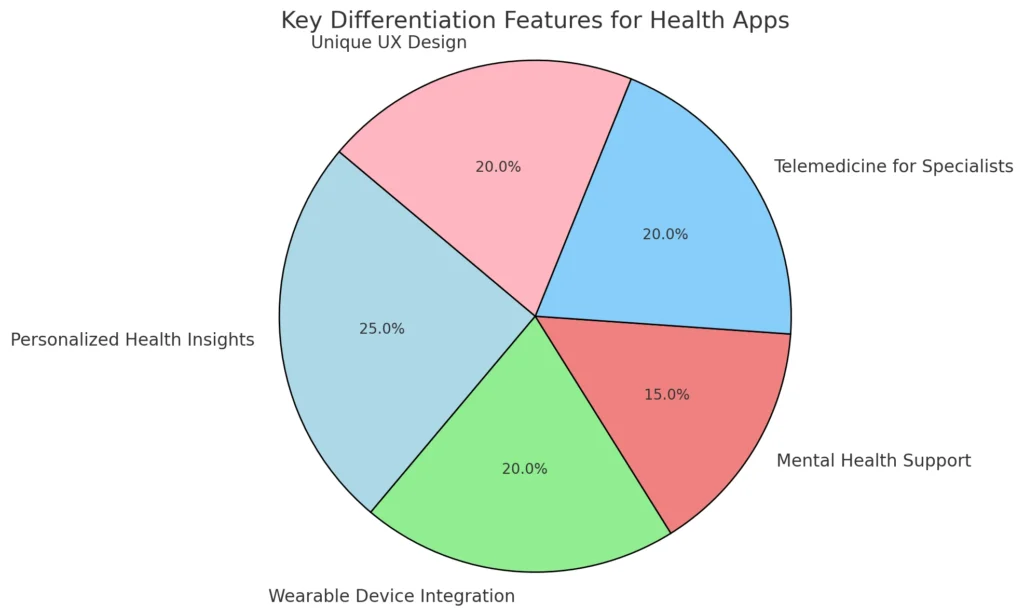
While building a healthcare app like K Health can put you in the fast-growing telemedicine market, standing out from the competition is crucial. Differentiating your app with unique features and an innovative user experience will give you an edge in attracting and retaining users. Here are some strategies to make your health app stand out:
1. Personalized Health Insights
One way to set your app apart is by offering deeper personalization. While K Health uses AI to provide generic medical advice, your app can go a step further by tailoring health insights based on the user’s medical history, lifestyle habits, and ongoing conditions. By creating a more personalized healthcare experience, users will feel more engaged and connected to your app.
2. Integration with Wearable Devices
As wearable health tech (like Fitbit and Apple Watch) becomes more popular, integrating your app with these devices can provide real-time data tracking for users. This feature will give users a holistic view of their health, including heart rate, activity levels, and sleep patterns. Offering this functionality can be a powerful differentiator, giving your app a cutting-edge advantage.
3. Mental Health Support
Adding mental health services alongside physical health features can also make your app more comprehensive. Offering access to therapists, guided meditation, or AI-driven mental health tools would cater to users looking for more than just physical healthcare. Mental wellness is a growing concern, and addressing it could significantly broaden your app’s appeal.
4. Telemedicine for Specialists
While general telemedicine is common, you can stand out by offering specialized telehealth services for niche areas like dermatology, cardiology, or pediatric care. This specialization makes your app the go-to solution for users looking for targeted healthcare services, setting it apart from broader, general-use apps like K Health.
5. Unique User Experience (UX) Design
User experience is everything in healthcare apps. Your app should be intuitive, easy to navigate, and visually appealing. Enhancing the user experience with seamless transitions, clear instructions, and an aesthetically pleasing design can elevate your app. Offering a better UX can help build loyalty among users, ensuring they return to your app for their healthcare needs.
Market Size, Growth, Revenue, and Business Model
| Market Segment | 2023 Value (in billion USD) | 2027 Projected Value (in billion USD) | CAGR (2023-2027) |
|---|---|---|---|
| Global Telehealth Market | $100 billion | $559 billion | 28% |
| U.S. Telehealth Adoption Rate | 38x increase since 2020 | Continuing growth expected | N / A |
| Subscription Revenue Model | Popular revenue stream | Projected growth in user adoption | Significant |
| Pay-per-Consultation | Widely adopted | Steady revenue stream | Alto |
| Compras dentro de la aplicación | Emerging model | Expected to increase as more services are added | Moderado |
| Asociaciones de afiliados | Growing revenue source | Increasing as more partnerships are formed | Alto |
| Anuncios | Low revenue currently | Potential to grow with larger user base | Moderado |
The telemedicine and digital healthcare markets are witnessing exponential growth. With increased demand for remote healthcare solutions, building an app like K Health positions you to tap into this lucrative market. The global digital health market was valued at over $100 billion in 2023 and is projected to grow at a compound annual growth rate (CAGR) of more than 28% in the coming years.
Market Size and Growth
The rise in mobile technology and an aging global population are driving the adoption of telemedicine apps. Governments and healthcare organizations are also promoting the use of digital health tools to ease the burden on traditional healthcare systems. In the U.S. alone, telehealth usage increased by 38 times compared to pre-pandemic levels. This growth is expected to continue, with the global telehealth market reaching an estimated value of $559 billion by 2027.
Flujos de ingresos
Telemedicine apps like K Health generate revenue through multiple channels:
- Modelos de suscripción: Users pay a monthly or annual fee to access healthcare services.
- Pay-per-Consultation: Users are charged for individual doctor consultations.
- Compras dentro de la aplicación: Selling digital healthcare services, such as wellness plans or advanced health reports.
- Asociaciones de afiliados: Partnering with healthcare providers, labs, or pharmacies to generate commissions from referrals.
- Anuncios: Monetizing through non-intrusive ads that fit the app’s medical theme, such as health insurance offers or pharmaceutical promotions.
Modelo de negocio
To create a successful business model for a healthcare app, it’s important to balance affordability and accessibility with quality healthcare services. A freemium model works well, where basic services are free, and users pay for advanced features or consultations. This model attracts a wide user base while generating revenue from premium users who need more personalized or specialized care.
Features of K Health
The success of K Health lies in its ability to combine advanced technology with user-centric features that make healthcare more accessible and convenient. When building a similar app, understanding and replicating these key features is crucial to delivering a high-quality experience that users will trust.
Key Features of K Health:
- Comprobador de síntomas basado en IA
One of K Health’s standout features is its AI-driven symptom checker. Users can input their symptoms, and the AI provides an initial diagnosis based on millions of medical data points. This not only reduces the need for immediate doctor consultations but also empowers users to manage their health more proactively. - Telemedicine Consultations
K Health allows users to connect directly with licensed doctors for virtual consultations. These consultations can cover everything from diagnosing common ailments to prescribing medication. Telemedicine services have become indispensable, especially during the COVID-19 pandemic, and they remain a key driver of the app’s popularity. - Personalized Health Profiles
The app creates personalized health profiles for each user, storing their medical history and past consultations. This allows for more accurate diagnoses and treatment recommendations based on the user’s unique health data. Having access to this information in one place simplifies the healthcare experience for users. - Affordable Pricing
One of the main reasons for K Health’s widespread adoption is its affordability. By using AI to manage initial diagnoses and offering low-cost telemedicine services, K Health has managed to reduce healthcare costs significantly for uninsured or underinsured individuals. This affordability is a key feature to consider when building your own healthcare app. - Data Security and Privacy
In the healthcare industry, ensuring data security and privacy is paramount. K Health complies with HIPAA regulations to protect user data. Building a secure app with encryption protocols and compliance with healthcare regulations is essential for establishing user trust.
Producto Mínimo Viable (MVP)
When building an app like K Health, starting with a Producto Mínimo Viable (MVP) is a smart approach. An MVP focuses on delivering the core features—such as the symptom checker and telemedicine consultations—while keeping costs and development time low. Once the MVP is live, you can gather user feedback to iterate and add more advanced features over time.
Technical Requirements
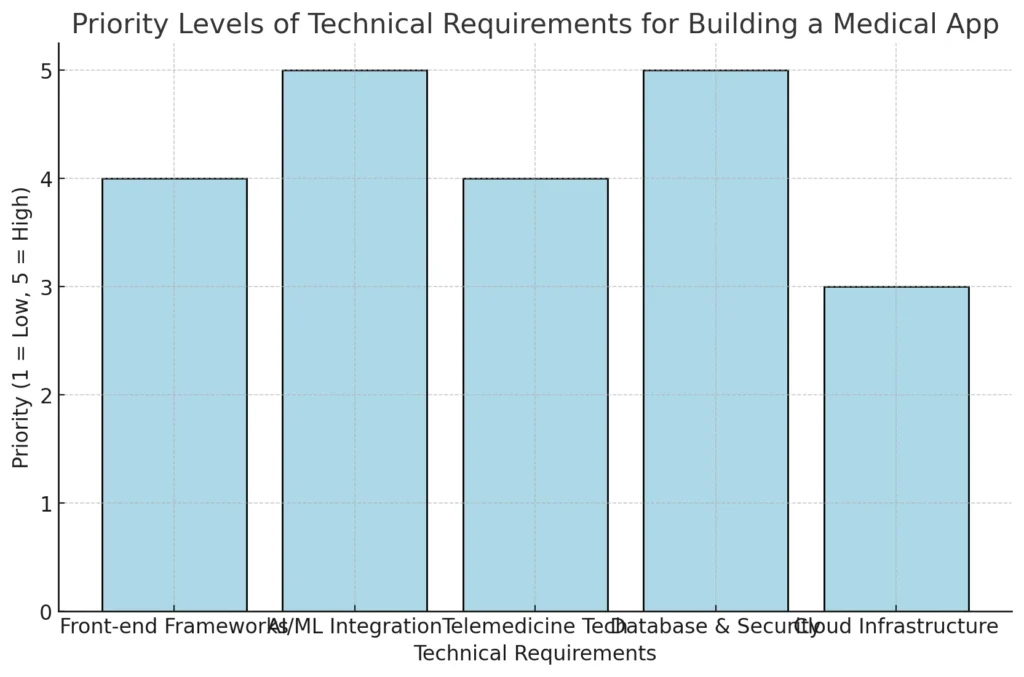
Building a medical app like K Health requires the right mix of technology to ensure seamless functionality, security, and scalability. Developing a telemedicine app involves integrating various tools, frameworks, and technologies to support real-time communication, AI-driven features, and secure data management. Let’s dive into the key technical requirements you’ll need for such an app.
1. Lenguajes de programación
To build a robust and scalable app, the choice of programming languages is critical. For the front-end, popular frameworks like Reaccionar nativo o Aleteo are often used, as they enable cross-platform development, meaning your app can run on both iOS and Android with a single codebase. On the back-end, languages like Node.js o Pitón are ideal for handling large amounts of data and managing AI models efficiently.
2. Inteligencia artificial (IA)
A core component of K Health is its AI-powered symptom checker. To replicate this, you’ll need access to large datasets of medical records and symptoms. Machine learning models trained on this data can provide accurate diagnostic predictions. Technologies like Flujo tensorial o PyTorch can be used for building and training these models, while NLP (Natural Language Processing) tools help interpret user inputs.
3. Telemedicine and Real-Time Communication
For telemedicine consultations, integrating WebRTC (an open-source project for real-time communication) allows users to have video calls with doctors. This framework ensures high-quality video streaming and secure connections. You may also need to incorporate voice and messaging functionalities, which can be achieved through APIs like Twilio.
4. Database and Security
Given the sensitive nature of healthcare data, security is a top priority. Your app needs to be HIPAA-compliant if you’re operating in the U.S. This involves ensuring that all patient data is encrypted and stored securely. Databases like MongoDB o PostgreSQL are frequently used for healthcare apps, with security layers to prevent data breaches. You’ll also need to implement SSL certificates, firewalls, y autenticación de dos factores (2FA) to further enhance data security.
5. Infraestructura en la nube
To scale your app efficiently, you’ll need a reliable cloud infrastructure. AWS (Servicios web de Amazon), Nube de Google, o Microsoft Azure provide scalable and secure cloud solutions for storing data, running AI models, and handling large user bases. These platforms also offer backup and disaster recovery options, ensuring that your app can maintain uptime even in unexpected situations.
Cloud services like Nube de Google provide scalable solutions to ensure your app runs smoothly as your user base grows.
Design and User Interface (UI/UX)
The design and user experience of a healthcare app like K Health can make or break its success. In the medical field, where users are often seeking urgent advice or consultations, ease of use and intuitive navigation are paramount. Your app should prioritize clear, user-friendly designs that make the healthcare journey simple, even for non-tech-savvy individuals.
1. Navegación sencilla e intuitiva
A user-friendly design ensures that patients can quickly find the services they need, whether it’s a symptom checker, telemedicine consultation, or accessing medical records. A clean and straightforward layout, with easily accessible buttons and menus, is essential for a healthcare app. Avoid clutter and confusing interfaces—simplicity is key.
2. Enfoque centrado en los dispositivos móviles
Since most users will access your healthcare app from mobile devices, the app should be designed with a mobile-first approach. This means optimizing the app for small screens, ensuring that text is legible and buttons are easy to tap. Responsiveness is crucial, as users will expect the app to work smoothly across different devices and screen sizes.
3. Color Scheme and Typography
The color scheme should inspire calm and trust, as healthcare apps are dealing with sensitive topics. Soft colors like blues and greens are often used because they evoke feelings of safety and reliability. Typography also plays a significant role—choose fonts that are easy to read and avoid overly complex designs.
4. Accessibility
A crucial part of any healthcare app’s design is ensuring that it’s accessible to all users, including those with disabilities. Features like text-to-speech, screen reader compatibility, and adjustable font sizes can make the app more inclusive. Incorporating accessibility features helps expand your user base and ensures compliance with accessibility standards.
5. Engaging User Interface
Even though the focus of a healthcare app is on functionality, adding elements that keep users engaged is important. Incorporating interactive elements like progress trackers, visual health stats, or even simple animations can enhance the user experience. However, these should be carefully balanced so they don’t distract from the core medical services.
6. Consistent Branding
Maintaining a consistent brand identity across all app screens builds trust with users. The design should reflect your brand’s core values, whether it’s professionalism, care, or innovation. Consistency in colors, logos, and design elements creates a seamless experience that helps users feel more comfortable.
Development Process
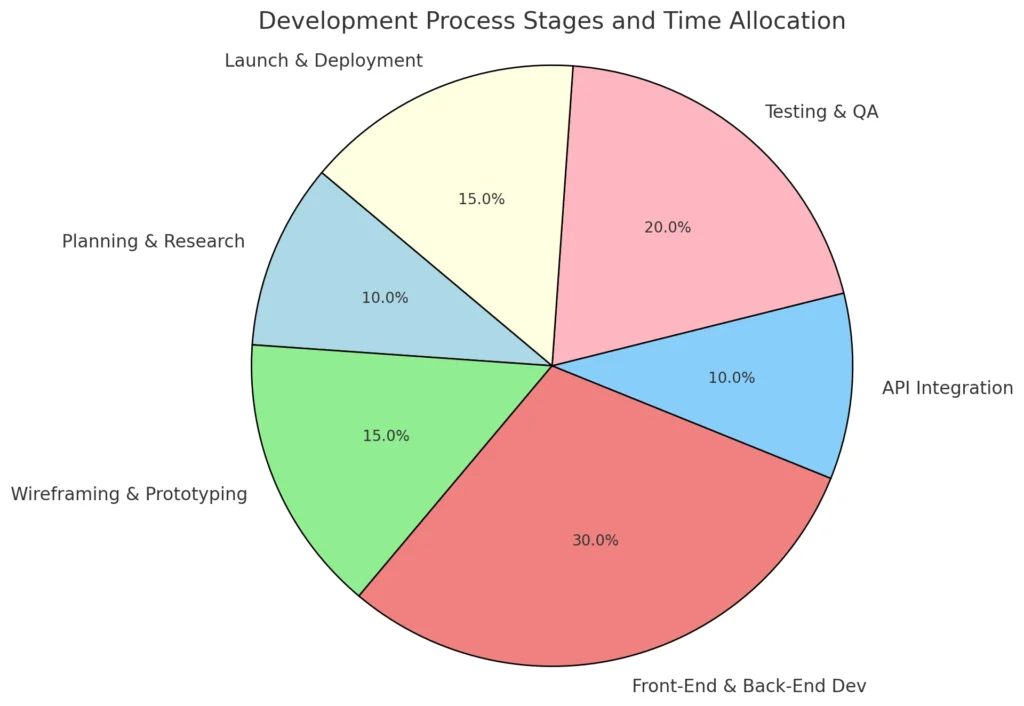
Building a healthcare app like K Health requires a well-structured development process. This ensures that the app is not only functional but also meets the highest standards of performance, security, and user experience. Below is a step-by-step guide that outlines the critical stages of development, from concept to launch.
1. Planning and Research
Before writing a single line of code, thorough planning and market research are essential. Start by identifying your target audience and understanding their pain points. Research competing healthcare apps to see what they offer, and determine how your app can stand out. This stage also involves creating a Producto Mínimo Viable (MVP) strategy, which focuses on the core features that will be included in the first version of the app.
2. Wireframing y creación de prototipos
Once you’ve outlined the key features and user flows, the next step is wireframing the app. A wireframe is essentially a blueprint of the app, showing the layout and functionality of each screen. Tools like Figma o Adobe XD are commonly used for this stage. After wireframing, you can create a prototype, which provides an interactive version of the app to test basic user interactions and flows.
3. Front-End and Back-End Development
The development phase is where the actual coding happens. In the front-end, developers will focus on building the user interface (UI) and user experience (UX), ensuring the app is responsive, smooth, and easy to navigate. The back-end focuses on server-side logic, database management, and security. This is also where AI and machine learning components (like K Health’s symptom checker) are integrated.
4. Integración API
Your app will likely need to interact with third-party services, especially for features like real-time video consultations or payments. This is done through APIs (Application Programming Interfaces), which allow your app to connect with other platforms. Popular APIs include Twilio for video and messaging services, and Raya o Paypal for payment processing.
5. Pruebas y control de calidad
Before launching the app, thorough testing is crucial. This stage involves Prueba unitaria, Prueba de integración, y Prueba de aceptación del usuario (UAT) to ensure that the app functions as intended and is free from bugs. Special attention should be given to testing the app’s security features, given the sensitive nature of healthcare data. Beta testing with a small group of users can also help identify usability issues that need to be fixed before the full launch.
6. Launch and Deployment
Once the app is tested and ready, it’s time for deployment. Depending on the platforms you’re targeting (iOS, Android, or both), you’ll need to submit the app to the respective app stores. This stage also includes setting up the infrastructure for the app to scale, such as cloud services or additional servers.
Cost Estimation and Timeframe
| Etapa de desarrollo | Global Cost Estimate (USD) | Miracuves Solutions Cost Estimate (USD) |
|---|---|---|
| Diseño de aplicaciones (UI/UX) | $1,500 – $5,000 | $150 – $500 |
| Front-End & Back-End Development | $10,000 – $40,000 | $1,000 – $4,000 |
| AI Integration | $5,000 – $15,000 | $500 – $1,500 |
| Telemedicine Integration | $3,000 – $10,000 | $300 – $1,000 |
| Seguridad y Cumplimiento | $2,000 – $5,000 | $200 – $500 |
| Costo total de desarrollo | $21,500 – $75,000 | $2,150 – $7,500 |
When building a medical app like K Health, one of the most critical considerations is the cost. Developing a telemedicine app requires a range of technical expertise and resources, from design and development to security and compliance with healthcare regulations. However, with smart planning and the use of ready-made solutions, you can significantly reduce both the cost and development timeframe.
Cost Breakdown
The total cost of building an app can vary based on features, complexity, and the region where the development team is located. Below are the key areas where costs will be incurred:
- App Design
A high-quality, user-friendly design is essential for any healthcare app. The cost of design includes wireframing, prototyping, and creating a polished user interface. On average, app design costs can range from $1,500 to $5,000. - Development (Front-End and Back-End)
Development is where the bulk of the costs lie. Front-end development focuses on creating a responsive, interactive user interface, while back-end development manages the server, database, and security features. Development costs typically range between $10,000 to $40,000, depending on the app’s complexity and the region where the developers are hired. - AI Integration
If you’re adding advanced features like K Health’s AI-powered symptom checker, this will add to your overall costs. AI and machine learning components can cost anywhere from $5,000 a $15,000, depending on the algorithms and training data required. - Telemedicine Integration
For real-time video consultations, you’ll need to integrate telemedicine functionalities, such as WebRTC for video and APIs for voice and chat. This can add an additional $3,000 to $10,000 to your budget. - Seguridad y Cumplimiento
Given the sensitive nature of healthcare data, ensuring HIPAA compliance is critical for apps operating in the U.S. Security features like encryption, two-factor authentication, and data backup will add to the cost, ranging from $2,000 to $5,000.
Periodo de tiempo
The development timeframe for an app like K Health can vary depending on the project’s scope. However, on average, developing a healthcare app can take anywhere from 4 a 6 meses. By using ready-made solutions, you can significantly reduce this timeframe—potentially delivering the app within 10 days to 1 month, depending on your needs.
Estrategias de monetización
Building a healthcare app like K Health isn’t just about providing a service—it’s also about generating revenue while delivering value to users. There are several monetization strategies you can adopt to ensure that your app remains profitable while maintaining affordability and accessibility for users. Here are some effective ways to monetize your telemedicine app:
1. Modelo basado en suscripción
One of the most popular monetization strategies is the subscription-based model. Users pay a monthly or yearly fee to access premium features, such as unlimited symptom checks, virtual consultations, or detailed health insights. This model ensures a consistent revenue stream, while still allowing users to try the app with a limited free version.
2. Pay-Per-Consultation
This approach allows users to pay for individual telemedicine consultations as needed. It’s an effective way to offer flexibility for users who may not want to commit to a subscription but still need access to healthcare professionals. Pay-per-consultation fees can vary depending on the service provided (e.g., general practitioner vs. specialist).
3. Compras dentro de la aplicación
Offering additional features or services through in-app purchases can also be a lucrative revenue stream. For example, users could purchase wellness plans, personalized dietary advice, or advanced diagnostic tools. In-app purchases can enhance the user experience by providing more in-depth features tailored to individual needs.
4. Asociaciones de afiliados
Partnering with healthcare providers, pharmacies, or wellness brands can bring in extra revenue through affiliate marketing. Your app can recommend relevant services or products, earning a commission for every user who makes a purchase through your referral. This method not only diversifies your revenue streams but also adds value for your users by offering complementary services.
5. Publicidad
While advertising is a common monetization strategy for many apps, in healthcare, it needs to be approached carefully. Ads should be relevant to the app’s purpose, such as promoting health insurance plans, fitness products, or medical supplies. Avoid intrusive or irrelevant ads that could disrupt the user experience, and consider offering an ad-free version for users willing to pay for a more streamlined experience.
6. Modelo Freemium
The freemium model offers basic services for free while charging for premium features. For example, users could access the symptom checker for free but pay for detailed reports or virtual consultations with doctors. This model helps attract a larger user base, while still offering an opportunity to convert free users into paying customers.
Launching and Marketing the App
Launching a healthcare app like K Health requires a well-planned strategy to ensure maximum visibility and user adoption from day one. The app’s success doesn’t just rely on its development and features, but also on how effectively it’s marketed and introduced to its target audience. Below are the key steps to launching and marketing your telemedicine app for a successful rollout.
1. Optimización de la App Store (ASO)
Getting your app to rank higher in app stores (Google Play, Apple App Store) is essential for attracting organic users. Focus on Optimización de la App Store (ASO), which includes using relevant keywords, an engaging app description, and eye-catching visuals. Be sure to highlight key features like AI-powered symptom checking, telemedicine consultations, and affordable healthcare services in the app description. Ratings and reviews also play a huge role in improving your app’s visibility—so encourage early users to leave positive feedback.
2. Pre-Launch Hype
Creating excitement around your app before its official release can help build anticipation and increase downloads upon launch. Use social media platforms to tease your app, share its key features, and highlight the problem it solves. Creating a pre-launch website or landing page where potential users can sign up for early access or notifications will help you build a database of interested users, which you can tap into immediately after the app goes live.
3. Targeted Social Media Campaigns
Digital marketing plays a pivotal role in app promotion. Paid advertisements on platforms like Facebook, Instagram, y LinkedIn allow you to reach your target demographic directly. For healthcare apps, your audience may include both patients and healthcare professionals. Tailor your marketing campaigns to highlight different features of the app that appeal to each group, whether it’s convenience, affordability, or access to professional medical advice.
4. Asociaciones con personas influyentes
Collaborating with healthcare influencers, bloggers, or even medical professionals can help establish trust in your app. Influencers can provide testimonials, reviews, or even demo the app in their content, giving their audience a first-hand look at how the app works. Their endorsement can lend credibility, particularly in the health and wellness space, where trust is key.
5. Content Marketing and SEO
Publishing valuable, healthcare-related content that solves your target audience’s problems can be a powerful tool in your marketing arsenal. Blog posts, articles, and videos on topics like “how to check your symptoms at home” or “the benefits of telemedicine” can not only educate your audience but also drive traffic to your app through organic search results. Ensure your content is optimized for SEO, using keywords relevant to healthcare and telemedicine.
6. User Retention and Engagement
After the initial launch, focus on retaining your users by maintaining an engaging user experience. Push notifications, regular feature updates, and personalized health reminders can keep users coming back to your app. Analyzing user behavior and feedback will also help you make necessary improvements, ensuring that your app continues to meet the evolving needs of its users.
Legal and Regulatory Considerations
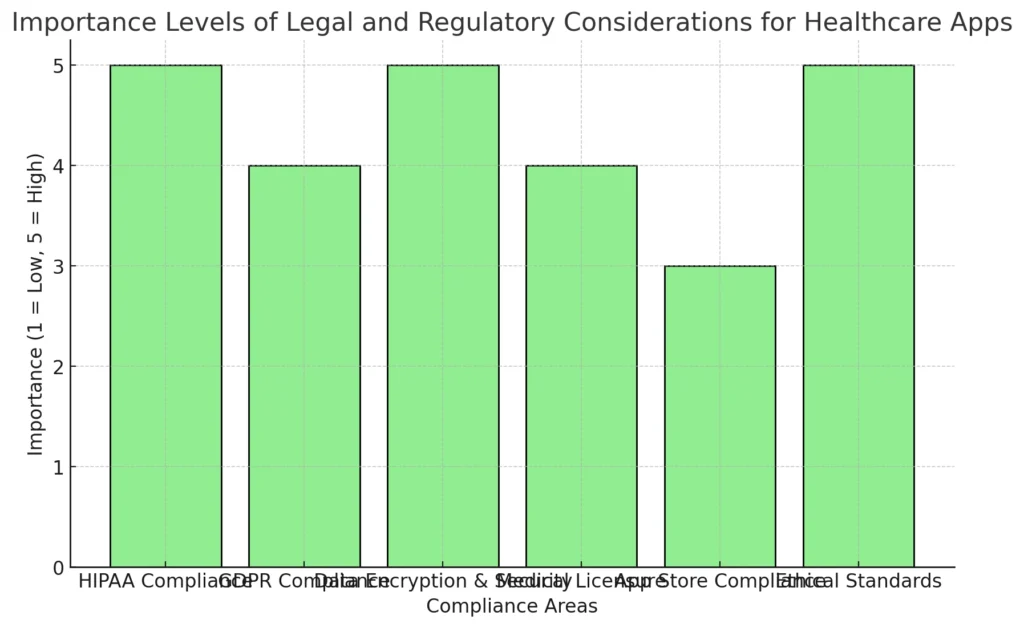
When developing a healthcare app like K Health, compliance with legal and regulatory requirements is not optional—it’s essential. Since healthcare apps deal with sensitive medical information, they are subject to strict regulations to ensure data privacy, security, and ethical medical practices. Failure to comply can result in hefty fines, legal actions, and damage to your app’s reputation. Here’s a breakdown of the most important legal and regulatory considerations to keep in mind.
1. HIPAA Compliance (U.S.)
If you’re targeting users in the United States, your app must comply with the Health Insurance Portability and Accountability Act (HIPAA). HIPAA regulations are designed to protect patients’ sensitive health information from being disclosed without their consent. Your app needs to ensure secure storage and transmission of personal health data, including encryption, access controls, and regular auditing of security measures.
If you’re targeting users in the United States, your app must comply with the HIPAA compliance regulations to protect patients’ sensitive health information.
2. GDPR Compliance (Europe)
If you plan to serve users in Europe, your app must comply with the Reglamento General de Protección de Datos (RGPD), which governs the collection and processing of personal data. GDPR gives users control over their personal data, requiring apps to obtain explicit consent before collecting any data. Additionally, users should be able to request deletion of their data at any time, and your app must have clear privacy policies in place.
3. Data Encryption and Security
Beyond regional regulations, maintaining robust security protocols is a must. Data encryption—both during transmission and while at rest—is critical for protecting sensitive medical data. Implementing autenticación de dos factores (2FA) and regular security audits will further strengthen your app’s defense against unauthorized access and cyber-attacks. You’ll also need to ensure your cloud infrastructure or servers comply with healthcare security standards.
4. Medical Licensure and Telemedicine Laws
If your app offers telemedicine services, it’s important to ensure that all healthcare professionals using the app are properly licensed to provide medical consultations in the regions where the app operates. Telemedicine laws vary by country, and even by state in some cases, so you’ll need to be diligent in ensuring that your platform complies with these regulations. Missteps here can lead to legal consequences for both the app and the healthcare providers.
5. App Store Compliance
Your app will also need to comply with the guidelines set by app stores (Google Play, Apple App Store) to be listed for download. These guidelines often include data privacy requirements, age restrictions for health-related apps, and limitations on in-app purchases for healthcare services.
6. Ethical Considerations
Ethical responsibility is crucial in healthcare. Users trust medical apps to provide accurate information, safe care, and privacy. Avoid making misleading claims about the app’s capabilities, ensure that diagnoses or symptom-check results are based on verified medical data, and provide clear disclaimers where necessary. Maintaining ethical standards not only protects users but also enhances your app’s credibility.
Future Growth of the App
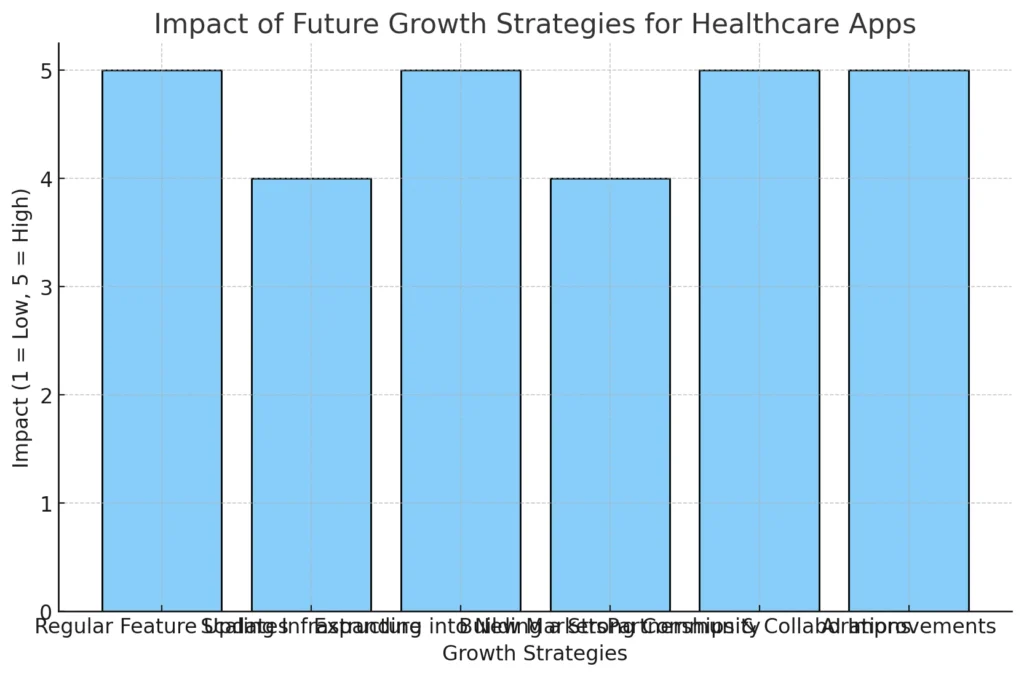
Once you’ve successfully launched your healthcare app, the focus shifts to its long-term growth and sustainability. Like any digital product, your app will need to evolve to meet the changing needs of its users and the broader healthcare landscape. Future growth is not just about scaling user numbers but also about continuously improving the app’s features, performance, and overall value. Here are some key strategies to ensure your app thrives in the long term.
1. Regular Feature Updates
To keep users engaged and attract new ones, you’ll need to continuously enhance the app’s functionality. Adding new features based on user feedback, industry trends, and advancements in technology will keep your app relevant. For example, integrating more advanced AI tools, offering specialized telemedicine services, or adding wellness tracking features can help differentiate your app from competitors.
2. Infraestructura de escalamiento
As your user base grows, you’ll need to ensure that your app’s infrastructure can scale seamlessly. Cloud services like AWS o Nube de Google allow for flexible scaling based on real-time demand. This ensures that as more users come on board, the app continues to run smoothly without compromising speed or performance.
3. Expanding into New Markets
Growth can also come from expanding your app’s reach into new geographic markets. Each region comes with its own set of regulations and healthcare needs, so you’ll need to ensure compliance with local laws and adapt features accordingly. For instance, telemedicine laws differ from country to country, so offering services in new regions requires understanding these nuances.
4. Building a Strong Community
One way to encourage long-term growth is by fostering a community around your app. Encourage users to share their experiences, provide feedback, and engage with healthcare professionals through the app. By creating forums, webinars, or user groups, you can build loyalty and a sense of belonging among your users, which will lead to better retention rates.
5. Partnerships and Collaborations
Forming partnerships with healthcare providers, insurers, or wellness companies can help your app grow faster. These collaborations can introduce your app to new audiences and provide additional revenue streams. For example, partnering with pharmacies for prescription services or with fitness brands for wellness integration could be mutually beneficial.
6. Continuous Improvement with AI
AI is constantly evolving, and leveraging new advancements in machine learning can enhance your app’s capabilities over time. For instance, as your app collects more user data, your AI symptom checker can become more accurate, offering even better health recommendations. Continuous improvement in AI features will add significant long-term value to your app.
Why Do You Trust Miracuves Solutions for Your Next Project?
When it comes to building a healthcare app like K Health, you need a partner who understands both the complexity of healthcare and the nuances of app development. Soluciones Miracuves offers a unique advantage in this space, providing not just development expertise but also ready-made solutions that save both time and money. Here’s why you can trust Soluciones Miracuves for your next project:
1. Unmatched Cost Efficiency
Developing a telemedicine app from scratch can be a costly endeavor, but Soluciones Miracuves offers a cost-effective alternative. By providing ready-made solutions that are tailored to your needs, Soluciones Miracuves can deliver a fully functional app at just 10% of the global cost. This allows businesses, both big and small, to enter the healthcare market without burning through their budgets.
2. Rapid Development Time
Time is critical in the tech world, especially when you’re trying to capture a growing market. While traditional development processes might take months, Soluciones Miracuves can deliver a healthcare app within as little as 10 days, compared to the industry standard of one month or more. This means you can launch faster, test your product, and iterate based on real user feedback without long delays.
3. Expertise in Healthcare Technology
Building a healthcare app requires not only development skills but also an understanding of healthcare regulations, user expectations, and security protocols. Soluciones Miracuves has years of experience in developing healthcare apps that are HIPAA-compliant, secure, and tailored to industry needs. Their expertise ensures that your app will not only function well but also meet all legal and regulatory requirements.
4. Customizable Ready-Made Solutions
The beauty of Soluciones Miracuves is that while they offer ready-made solutions, they are fully customizable. This means you get the best of both worlds—speed and affordability—without sacrificing the ability to tailor the app to your unique vision. Whether you want to add specific features, integrate third-party APIs, or enhance the user experience, Soluciones Miracuves can make it happen.
5. Soporte y mantenimiento continuo
Launching the app is just the beginning. Soluciones Miracuves provides ongoing support and maintenance to ensure that your app continues to run smoothly, scales efficiently, and stays updated with the latest technological advancements. From bug fixes to feature updates, you can rely on their team to keep your app in top condition.
Elección Soluciones Miracuves means partnering with a company that prioritizes quality, efficiency, and long-term success—exactly what you need to thrive in the competitive healthcare market.
Conclusión
Building a healthcare app like K Health is not just an exciting venture, but also a strategic move to enter a rapidly growing and vital industry. By integrating AI-powered features, telemedicine capabilities, and user-friendly designs, you can create an app that offers real value to users, improves access to healthcare, and drives innovation in the medical field.
Con Soluciones Miracuves, the process becomes even more streamlined, offering you ready-made solutions at just 10% of the global cost and with a drastically reduced development timeframe. Whether you’re looking to scale quickly, customize your app for a specific market, or ensure your app is secure and compliant, Soluciones Miracuves has the expertise to guide you every step of the way.
By making the right choices in design, development, and monetization, your app can stand out in the competitive healthcare market and provide lasting benefits to users while delivering substantial business growth.
Preguntas frecuentes
How much does it cost to build an app like K Health with Miracuves Solutions?
Con Soluciones Miracuves, you can expect to pay around 10% of the global development cost. This means what typically costs $60,000 globally could be delivered for as low as $6,000 using Miracuves’ ready-made solutions.
How quickly can I launch my healthcare app?
The development process can be completed in as little as 10 days with Soluciones Miracuves, compared to the traditional timeframe of 1 month or more.
What features are essential for a healthcare app like K Health?
Essential features include an AI-powered symptom checker, telemedicine consultations, health data storage, and a user-friendly interface. Security and compliance with regulations like HIPAA are also critical.
What legal requirements do I need to consider?
You’ll need to ensure compliance with healthcare regulations such as HIPAA in the U.S. and RGPD in Europe. Data security, user privacy, and licensing for medical professionals are all necessary legal considerations.
How can I differentiate my healthcare app from others?
You can differentiate by offering personalized health insights, integrating with wearable devices, focusing on mental health, or providing niche telemedicine services like specialist consultations.

